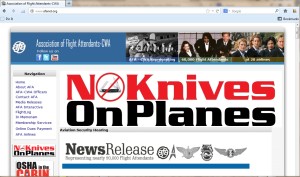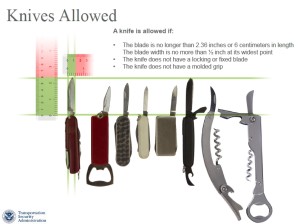Pummeled by Special Interests, TSA Reverses Changes to Small Blade Restrictions
After roughly three months of contentious argument, the Transportation Security Administration announced Wednesday that it was reversing its decision to allow certain small knives aboard planes. While discussion over just how to screen passengers for maximum security benefit continues, passengers will not be able to bring even the smallest pocketknives into the cabin any time soon, despite the lobbying efforts of groups like The American Knife and Tool Institute and Doug Ritter’s Knife Rights.
When the TSA announced in early March that it would permit certain small pocketknives aboard flights, the response was predictable. While knife owners rejoiced at this rare act of sanity from government (and quasi-governmental entities), much hand-wringing ensued from citizens and government figures alike. How could the TSA make such a decision, given the nature of the September 11th, 2001 attacks? What could possibly motivate the TSA to permit sharp objects in airplane cabins?
“This is part of an overall Risk-Based Security approach,” read the TSA’s blog at the time, “which allows Transportation Security Officers to better focus their efforts on finding higher threat items such as explosives. This decision aligns TSA more closely with International Civil Aviation Organization (ICAO) standards.” The blog post goes on to point out that razor blades and box-cutters would still be still prohibited in carry-on luggage.
The implications seemed clear enough: The threat from the types of small, non-locking pocketknives the TSA would have permitted (originally as of 25 April, 2013) through airport security checkpoints is relatively low. Simply put, these tiny utility blades don’t offer much of a threat. Hunting for them and confiscating them takes more time than TSA personnel wanted to spend. They have finite resources and a lot of ground to cover in a typical day of air travel; therefore, they would rather have spent their time looking for things like bombs that can bring down an entire plane, rather than pocketknives that pose relatively little danger.
Unspoken in the now aborted policy revision was the acknowledgment, too, that the air travel paradigm has changed. Where once it was possible for men armed with blades to take over an aircraft, passengers now know that simply complying with hijackers’ demands does not guarantee their safety. There was a time when you could be reasonably certain, provided you could endure the experience, that you would end up safely back on the ground if a passenger jet was seized. September 11th changed that — and citizens changed their behavior accordingly. Today a would-be hijacker is much more likely to be tackled and beaten by wary travelers, whose fates may well be sealed if they do not resist.
The change in TSA policy was nonetheless opposed by a variety of special interest groups and unions, most notably Airlines for America, FliersRights.org, the Federal Law Enforcement Association, the American Federation of Government Employees, and the Association of Flight Attendants (AFA).
The AFA’s opposition was particularly political. Its website describes the organization as “the world’s largest labor union organized by flight attendants for flight attendants. AFA represents nearly 60,000 flight attendants at 20 airlines, serving as a voice for flight attendants at their workplace, in the industry, in the media and on Capitol Hill.” Shortly after the announcement by the TSA that it would relax knife restrictions on planes, an enormous graphic on the AFA website, www.afanet.org, proclaimed, “No Knives On Planes.”
“The knife lobby,” sneered the AFA’s web copy, “representing a group of knife manufacturers, gloated that their efforts to lobby the TSA for years finally ‘paid off’ and they were ‘instrumental’ in getting the TSA to change the policy. …Now they are on Capitol Hill fighting us. So the TSA policy change is not about aviation security and it’s certainly not about the safety of crewmembers or the traveling public — it’s about corporate interests and their paid lobbyists. …We have to make sure knives are not allowed back on our planes. At great cost, we know the danger of lifting the ban on knives.”
TSA Director John Pistole defended the policy change in mid-March, saying before a Homeland Security subcommittee that he “could have done a better job” of involving flight attendant groups (like the AFA) and law enforcement agencies in the decision to modify screening rules. He insisted, however, that improvised explosives are the more significant threat. The guidelines to which the TSA would have begun screening in April matched (as indicated on the TSA’s blog) those of the International Civil Aviation Organization, a United Nations agency that promotes air travel safety worldwide.
Ultimately the debate over the TSA’s rules revolved around those special interest groups and politicians angry that they weren’t consulted prior to the change. Politico reported that House Homeland Security Chairman Mike McCaul was irate over learning of the change through media reports. Pistole, undeterred, insisted that he was aware of no incidents involving knives of the type TSA wanted to allow aboard, while explaining that the screening time now allotted to finding thousands of pocketknives in travelers’ pockets and carry-on bags is simply resource-prohibitive.
Per a PDF file distributed last spring through the TSA’s website, a knife would have been explicitly allowed if…
- It had a blade shorter than 2.36 inches (6 centimeters)
- The blade was no wider than .5 inch at its widest point
- The blade did not lock (and the knife was not a fixed blade)
- The knife did not have a “molded” grip
Exactly what constitutes a “molded grip” was unclear at the time. The TSA’s PDF file offered specific examples of prohibited knives, to include all fixed blades, knives with wide blades, knives with finger-grooved plastic handles, and even a knife with finger-holes in its grip. A Swiss Army Knife (or a copy thereof) was shown among its examples of knives that would be allowed onboard, as were various keychain folders, bottle openers, and “wine knives.” (Curiously, among the other items that would have been allowed onboard planes were hockey sticks, golf clubs, and novelty miniature baseball bats.)
After first delaying implementation of the rules change from April to an unspecified date, the debate ended on 6 June, 2013, when Pistole announced TSA was dropping the change. The result is no change. TSA personnel will continue to waste screening time rooting out blades that represent very little actual threat, while honest citizens are harassed for carrying even the most basic of utility blades.
The problem with all screening rules is that, in the absence of a list of explicitly permitted knives by brand, unless the knife in question matches a knife on some list issued by the agency, it is virtually impossible to guarantee that a carried blade will or will not make it onboard. A lot depends on the discretion of individual screeners, as anyone who has flown in the last decade can attest. Then, too, there is the possibility that a small knife could simply be missed by one screener and flagged by another. TSA personnel are far from infallible and security screening horror stories abound.
For now, politicking and resistance from special interests have guaranteed nothing changes in domestic air travel. A policy revision first hailed as a victory for those organizations supporting Americans’ knife rights has become an embarrassing reversal for John Pistole. It remains to be seen whether, at some future date, these rules might again be revisited.



